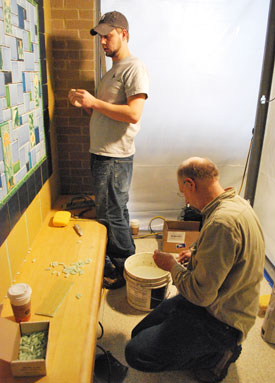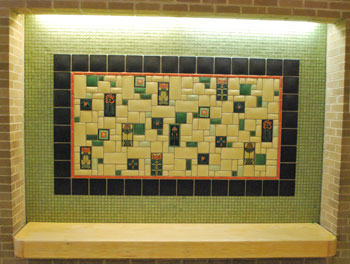Motawi Murals Mix Art, Practicality

Detail of a Motawi mural installed on the 5th floor of the UM Hospital. This design is called the Button Basket.
Bill and Matt Ransom clearly are experts and take their work seriously, but there was plenty of good-natured ribbing between the father and son when The Chronicle peeked into their cloistered workspace on the 8th floor elevator lobby of the University of Michigan Hospital. When Matt poked his father with a tape measure while Bill was slathering tile mud on the wall – Bill just kept on working.
The Ransoms were installing an 8×10-foot mural designed by Motawi Tileworks, one of 14 “Tile Quilts” – each one unique – that the hospital has commissioned from Motawi since 2005. It’s a project that started out small but has now become a signature part of the building, and a kind of artful wayfinding system for patients and visitors.
The Chronicle heard about the recent installations at an Ann Arbor Public Art Commission meeting, when commissioner Elaine Sims reported to the group that another set of murals was going up in January. Sims is director of the Gifts of Art program at the University of Michigan Health System, which is responsible for the project.

Matt and Bill Ransom work together to install the glass tile border around the Motawi mural, which was already in place but not yet grouted.
Colleen Crawley, project designer for Motawi, said that Sims had originally contacted the Scio Township firm about doing murals just in the two first-floor elevator lobbies. Motawi’s original proposal was for custom-made murals, which turned out to be too high for the Gifts of Art budget. “But we didn’t give up,” Crawley said.
Instead of walking away when their proposal was turned down, Motawi designers looked at making a collage out of their standard tile designs to reduce costs. They also shrank the mural and added a foot-wide border of small, less expensive glass tiles around the outside edge. Crawley said they surprised Sims by returning with a new, lower-priced bid – one that got an enthusiastic approval.
Over the years, Gifts of Art has expanded the project. In 2006, Motawi murals went up in the second-floor elevator lobbies. Murals in the fourth and fifth floors were added in 2008, and this year they’re being installed on floors six through eight. There are proposals in the works for additional pairs in the basement level and ninth floor, but those haven’t been approved yet, Crawley said.
Both Crawley and Carrie McClintock, the Gifts of Art communications coordinator, mentioned the practical qualities of these ceramic-tile murals. The tile is extremely durable – almost indestructible, Crawley said, and can be easily cleaned by wiping off the surface. (This also makes them popular for places like the Ann Arbor District Library’s Pittsfield branch, the Ann Arbor YMCA and Ann Arbor Hands-On Museum, where Motawi murals are also installed.)
McClintock, who was also The Chronicle’s guide through the hospital (no free-range journalists are allowed on the premises), noted how tactile the murals are, and how patients like to touch them. That’s an advantage over other types of art, which are typically framed and behind glass or in a display case. A letter sent to Motawi from Lisa Danielson, an educational nurse coordinator at the hospital, makes this point explicitly (Danielson gave permission to quote the letter, excerpted here):
I work on an Acute Adult Rehabilitation unit. Most of the patients rely on a wheelchair for their mobility to get from one floor to the other for treatments and therapy. Your works are strategically placed at an accessible level for them to see and touch. I have observed many patients and visitors, adults and children, viewing and feeling the art work you created. I cannot tell you how moved I am when I see this interaction happen. It is a wonderful thing in life when something comes together so beautifully and completely.

An 8x10-foot Motawi mural on the 2nd floor (east elevator lobby) of the UM Hospital. The mural also serves as a backdrop for a wooden bench in the elevator lobby.
The Ransoms, via their Ransom Ceramic Tile business, are Motawi’s go-to installers in the Ann Arbor area – they’ve done all of the hospital murals. By Friday morning, they had placed all the ceramic tiles but hadn’t yet grouted. When The Chronicle arrived, they were putting up the small blocks of glass tiles in the border, which 28-year-old Matt described as a bit of a pain to install. They come in sheets about a foot square, held together by paper adhered to the part of the tile that faces out. The timing is tricky: You apply the mortar (called mud) to the wall, then press the square of tiles into place. You have to wait until it sets a bit – if you peel off the paper backing too soon, the glass tiles will slide off. If you peel it off too late, the mud will have hardened and you won’t be able to shift the tiles into place, if they aren’t aligned.
This work is done out of the public eye: A plastic tarp creates a small workspace around the mural, and a device outside the zippered entry filters air to minimize impact on the patient floors. It’s not for the claustrophobic.
So what does it cost to build a mural like this? Crawley said in general, Motawi murals cost roughly $400 a square foot. Matt Ransom had a tip for potential customers who like the tiles but need a lower-priced option: Motawi’s semi-annual sales are one popular way to find bargains, but Ransom also pointed out that the firm’s seconds room (also known as the Bone Yard) is open year-round.




Interesting article – I love tile/mosaic myself, and the installation looks very nice and professional. I bet the smooth tile is nice to touch.
For tile-hounds: there are Motawi and I believe Pewabic tile installations in the School of Education building (former Ann Arbor High School) on E. University – a great tile fountain and wall/floor work on the South side and also a donor recognition piece with a tile border near the East entrance.
Now, does anyone know – are these hospital murals in any way funded by the Ann Arbor Public Art funds? I hope not – the U of M Hospitals are not what I think of when I think public space – you said it in the article – you had to be accompanied into the hospital to view them. I believe that he 4the/Washington parking structure mosaics are from that funding. $400 a square foot is pretty steep, right? I know they will last a long time, and hope they will be moved if they remodel ala Arborland’s “Jack and the Beanstalk” now located in Kerrytown!
Yes, Motawi tiles are indeed gorgeous, and the murals in the University Hospital are well worth seeing. The U-M hospitals are public spaces, open to all. The only visitors who require supervision are members of the press when interviewing and taking photographs because of patient privacy and other health and safety issues. The murals were not built with Ann Arbor Public Art Funds. I would like to extend a warm welcome to visitors to come and visit the spacious, airy, and light filled exhibit spaces of the University of Michigan Health System, containing both permanent art and nine rotating exhibit galleries.
Your local hand made art tile studio, Motawi Tileworks, has a free studio tour on Thursday mornings at 11 am. Come on out and see us!
Well… I wish I lived closer to be able to stop by and see the exibits and your program. Sounds like a very satisfying program to be involved. Keep up the good work … Dave